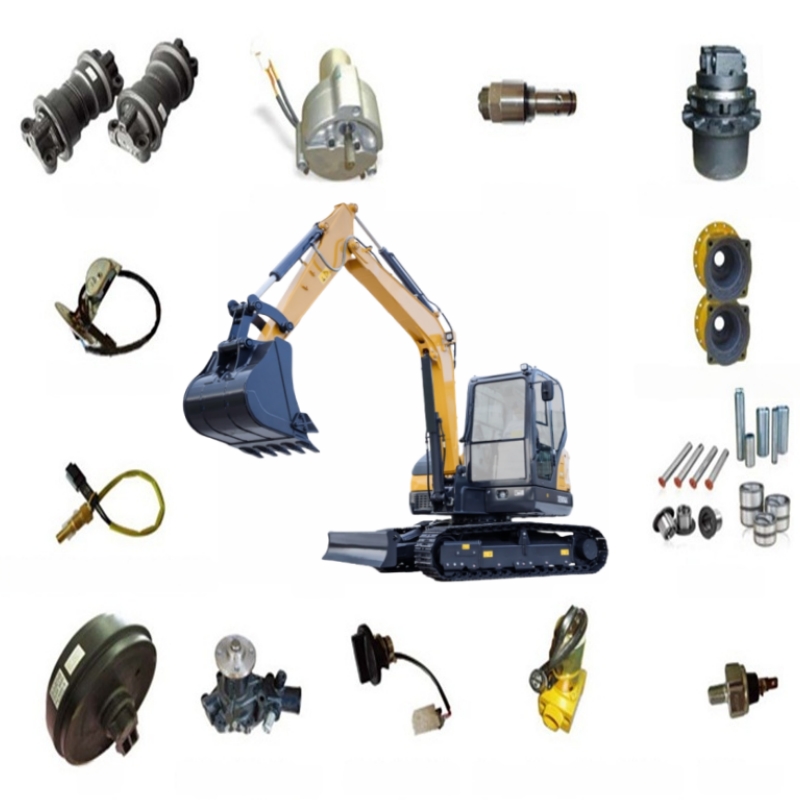Excavators play a vital role in the construction machinery industry, widely used in numerous industries, including construction, mining, and road construction. Excavator parts, as a key component for ensuring their proper operation, have a direct impact on their efficiency, service life, and operational safety. This series of articles will delve into various aspects of excavator parts, providing comprehensive knowledge and practical advice.
1. The Importance of Excavator Parts
High-quality excavator parts are essential for ensuring efficient and stable excavator operation. For example, high-quality hydraulic pumps, distribution valves, and cylinders precisely control the flow and pressure of hydraulic oil, ensuring smooth and powerful movement of the excavator’s boom, arm, and bucket, significantly improving the efficiency of operations such as excavation and loading and unloading. Conversely, using inferior hydraulic parts can lead to leaks and unstable pressure in the hydraulic system, significantly reducing operating efficiency and potentially causing safety accidents due to sudden failures.
Adaptable and durable parts are also essential for extending the life of equipment. For example, in an excavator’s travel system, durable rollers, carrier rollers, and track shoes withstand the immense pressure and friction of navigating complex terrain, reducing wear and extending the service life of the entire travel system. Using poor-quality travel system parts will lead to frequent replacements, increasing maintenance costs and delaying project progress due to downtime.
Operational safety is even more closely linked to the quality of the parts. For example, if the brake pads of the brake system are severely worn or the brake pump is performing poorly, emergency braking may not be able to occur promptly and effectively, potentially causing serious safety accidents and endangering the lives of the operator and surrounding personnel.
II. Common Excavator Parts Classification and Functions
(I) Power System Parts
Engine: As the “heart” of the excavator, the engine provides power for the entire machine. Engine parameters such as power and torque vary between excavator brands and models to meet varying operating requirements. For example, large-scale mining operations typically require powerful, high-torque engines to power excavators for intense excavation. Smaller projects, such as urban construction, require less power, but may prioritize fuel efficiency and emissions.
Fuel system components include fuel filters, fuel pumps, and fuel injectors. The fuel filter effectively filters impurities from the fuel, preventing them from entering the engine and protecting delicate components from wear. The fuel pump transports fuel from the tank to the engine, maintaining sufficient pressure. The fuel injectors spray the fuel into the engine’s combustion chamber in atomized form, ensuring optimal combustion, directly impacting the engine’s power output and fuel efficiency.
(II) Hydraulic System Components
Hydraulic pumps convert the engine’s mechanical energy into hydraulic energy, providing power for the entire hydraulic system. Common hydraulic pumps include gear pumps, vane pumps, and plunger pumps. Plunger pumps are widely used in large excavators due to their high pressure, high flow rate, and high efficiency.
Distribution valves: Control the flow and pressure of hydraulic oil, distributing it from the hydraulic pump to various actuators (such as cylinders and motors) to achieve the movement of the excavator’s various working devices. The performance of the distribution valve directly affects the response speed and precision of the hydraulic system.
Cylinders: Convert hydraulic energy into mechanical energy, achieving linear reciprocating motion, driving the excavator’s boom, arm, bucket, and other working devices for lifting, retracting, and digging. Parameters such as cylinder sealing and piston rod strength are crucial to their performance and service life.
(III) Working Device Accessories
Booms and arms: The boom and arm are the primary components of an excavator for excavating and handling materials. Their structural strength and rigidity directly impact the excavator’s operating capacity. In some special operating conditions, such as when digging deep foundation pits or handling materials over long distances, extended booms and arms are often used.
Buckets: Buckets come in various types depending on the work object and working conditions. Standard buckets are suitable for general earthwork excavation; rock buckets are made of high-strength, wear-resistant materials for excavating hard rock; and ditch buckets are designed with a special shape for excavating in narrow terrain such as ditches.
(IV) Travel System Accessories
Rollers: Support the weight of the excavator and keep the tracks rolling in the correct direction. Rollers are subject to significant pressure and friction during operation and therefore require excellent wear resistance and load-bearing capacity.
Carrier Rollers: Support the tracks, preventing them from sagging excessively and ensuring smooth operation. Carrier Rollers also require good wear resistance and rotational flexibility.
Tracks: Available in steel and rubber. Steel tracks offer high strength and wear resistance, making them suitable for harsh terrain conditions such as mines and quarries. Rubber tracks are quieter and less disruptive to the ground, making them commonly used in environmentally sensitive applications such as urban construction. (V) Electrical System Accessories
Starter Motor: Responsible for starting the engine, converting electrical energy into mechanical energy, driving the engine crankshaft, and putting the engine into operation.
Controller: Monitors and controls various excavator systems, such as engine speed and hydraulic system pressure and flow, enabling automated operation and intelligent management of the excavator.
Sensors: These include oil temperature sensors, water temperature sensors, and pressure sensors. They monitor the operating parameters of various excavator systems in real time and transmit signals to the controller, allowing the controller to adjust and control the excavator accordingly.
This concludes our discussion on the importance and classification of excavator accessories. We will continue to analyze the key points of selecting excavator accessories. Interested parties should stay tuned. If you need to purchase excavator spare parts, please contact us directly. We will provide you with high-quality and affordable accessories!
You can also visit some of our websites:
Click here to visit our spare parts web
Click here to visit our alibaba (There are more kinds of products)
Post time: Aug-20-2025


